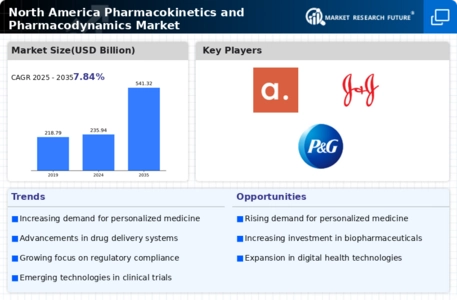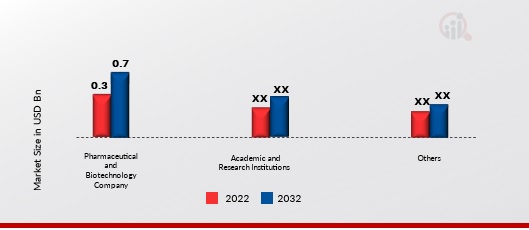Market Growth Projections
The Global North America Pharmacokinetics and Pharmacodynamics Market Industry is projected to experience substantial growth over the coming years. With a market value of 235.94 USD Billion in 2024, it is anticipated to reach 541.32 USD Billion by 2035, reflecting a compound annual growth rate (CAGR) of 7.84% from 2025 to 2035. This growth is driven by various factors, including technological advancements, increasing demand for personalized medicine, and a supportive regulatory environment. As the industry evolves, stakeholders are likely to capitalize on emerging opportunities, further enhancing the market's potential.
Rising Demand for Personalized Medicine
The Global North America Pharmacokinetics and Pharmacodynamics Market Industry is experiencing a notable surge in demand for personalized medicine. This trend is driven by advancements in genomics and biotechnology, which enable tailored therapeutic approaches based on individual patient profiles. As healthcare providers increasingly adopt precision medicine strategies, the market is projected to reach 235.94 USD Billion in 2024. This shift towards personalized therapies not only enhances treatment efficacy but also minimizes adverse effects, thereby fostering patient compliance and satisfaction. Consequently, the industry is likely to witness robust growth as stakeholders invest in research and development to optimize drug formulations.
Emerging Biologics and Biosimilars Market
The emergence of biologics and biosimilars is reshaping the Global North America Pharmacokinetics and Pharmacodynamics Market Industry. Biologics, which are derived from living organisms, require comprehensive pharmacokinetic and pharmacodynamic evaluations to ensure their safety and efficacy. As the demand for these therapies increases, driven by their effectiveness in treating complex diseases, the market is likely to witness significant growth. The biosimilars segment, in particular, is gaining traction as it offers cost-effective alternatives to expensive biologics. This trend is expected to contribute to the overall market expansion, aligning with the industry's projected growth trajectory.
Growing Focus on Chronic Disease Management
The rising prevalence of chronic diseases in North America is driving the Global North America Pharmacokinetics and Pharmacodynamics Market Industry towards innovative therapeutic solutions. Chronic conditions such as diabetes, cardiovascular diseases, and cancer necessitate effective pharmacological interventions that are informed by pharmacokinetic and pharmacodynamic principles. As healthcare systems increasingly prioritize chronic disease management, pharmaceutical companies are investing in research to develop targeted therapies that optimize drug efficacy and safety. This focus is expected to propel market growth, with the industry poised for substantial expansion as it adapts to the evolving healthcare landscape.
Technological Advancements in Drug Development
Technological innovations are transforming the landscape of the Global North America Pharmacokinetics and Pharmacodynamics Market Industry. The integration of artificial intelligence and machine learning in drug discovery processes is streamlining the identification of potential drug candidates, significantly reducing time and costs associated with traditional methods. These advancements facilitate more efficient pharmacokinetic and pharmacodynamic modeling, which is essential for predicting drug behavior in the human body. As a result, the market is expected to expand, with projections indicating a growth trajectory that could see it reach 541.32 USD Billion by 2035. This technological evolution is likely to attract substantial investments from pharmaceutical companies.
Increasing Regulatory Support for Drug Approvals
Regulatory bodies in North America are enhancing their frameworks to expedite drug approvals, thereby positively impacting the Global North America Pharmacokinetics and Pharmacodynamics Market Industry. Initiatives aimed at streamlining the approval process for new drugs and biologics are fostering an environment conducive to innovation. For instance, the FDA's 21st Century Cures Act has introduced measures that encourage the use of real-world evidence in regulatory decision-making. This supportive regulatory landscape not only accelerates the time-to-market for new therapies but also stimulates investment in pharmacokinetics and pharmacodynamics research, contributing to the market's anticipated CAGR of 7.84% from 2025 to 2035.















Leave a Comment